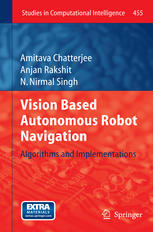

Most ebook files are in PDF format, so you can easily read them using various software such as Foxit Reader or directly on the Google Chrome browser.
Some ebook files are released by publishers in other formats such as .awz, .mobi, .epub, .fb2, etc. You may need to install specific software to read these formats on mobile/PC, such as Calibre.
Please read the tutorial at this link: https://ebookbell.com/faq
We offer FREE conversion to the popular formats you request; however, this may take some time. Therefore, right after payment, please email us, and we will try to provide the service as quickly as possible.
For some exceptional file formats or broken links (if any), please refrain from opening any disputes. Instead, email us first, and we will try to assist within a maximum of 6 hours.
EbookBell Team

4.1
20 reviewsThis monograph is devoted to the theory and development of autonomous navigation of mobile robots using computer vision based sensing mechanism. The conventional robot navigation systems, utilizing traditional sensors like ultrasonic, IR, GPS, laser sensors etc., suffer several drawbacks related to either the physical limitations of the sensor or incur high cost. Vision sensing has emerged as a popular alternative where cameras can be used to reduce the overall cost, maintaining high degree of intelligence, flexibility and robustness.
This book includes a detailed description of several new approaches for real life vision based autonomous navigation algorithms and SLAM. It presents the concept of how subgoal based goal-driven navigation can be carried out using vision sensing. The development concept of vision based robots for path/line tracking using fuzzy logic is presented, as well as how a low-cost robot can be indigenously developed in the laboratory with microcontroller based sensor systems. The book describes successful implementation of integration of low-cost, external peripherals, with off-the-shelf procured robots. An important highlight of the book is that it presents a detailed, step-by-step sample demonstration of how vision-based navigation modules can be actually implemented in real life, under 32-bit Windows environment. The book also discusses the concept of implementing vision based SLAM employing a two camera based system.